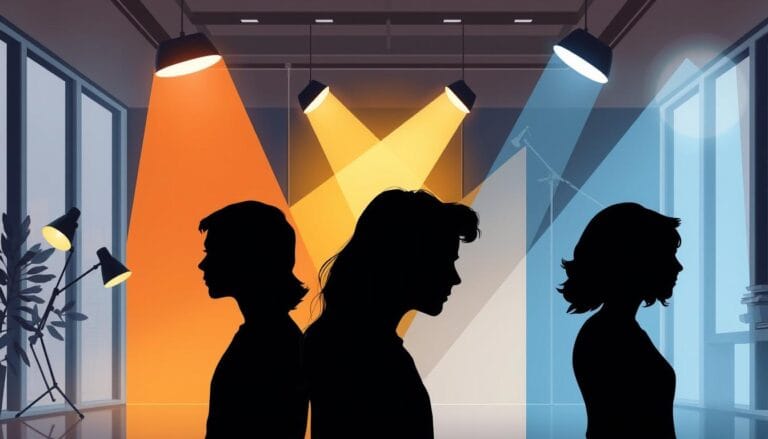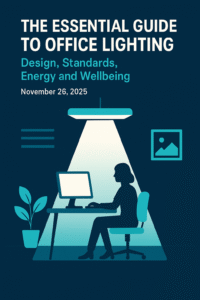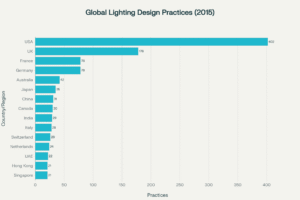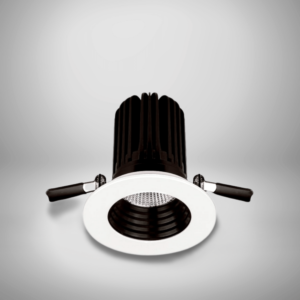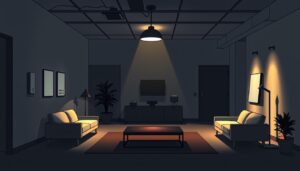“Light is to the spirit what food is to the body,” said Carl Jung, a renowned psychologist. He highlighted the deep connection between light and our inner world. As we explore light psychology, we discover how lighting influences our emotions and shapes our daily lives.
Recent studies have revealed the remarkable speed at which light impacts our physiology and behaviour. Just minutes after exposure, light can alter our heart rate and body temperature. Moreover, it can affect our limbic structures, such as the amygdala and hippocampus (the parts of our brain responsible for regulating emotions), in seconds.
The discovery of intrinsically photosensitive retinal ganglion cells (ipRGCs) has transformed our understanding of light’s emotional impact. These cells are vital for non-visual responses, including mood regulation and maintaining our circadian rhythms.
As we look into the illumination’s effect on mood, we’ll uncover the complex mechanisms linking our surroundings to our emotional states. This exploration will show how light and our biology interact, influencing our productivity and social interactions.
Key Takeaways
- Light can trigger physiological changes within minutes of exposure
- Functional imaging studies show light’s rapid influence on limbic structures
- Discovery of ipRGCs has revolutionised our understanding of light’s non-visual effects
- Light plays a crucial role in mood regulation and circadian rhythm maintenance
- Understanding light psychology can help optimise our emotional well-being
Understanding the Science of Light and Mood
The connection between lighting design and our emotional state is rooted in science. We’ve uncovered mechanisms that show how light impacts our mood and health.
The Role of Intrinsically Photosensitive Retinal Ganglion Cells
A small but crucial group of cells in our eyes, known as intrinsically photosensitive retinal ganglion cells (ipRGCs), are critical to our light response. These cells, making up less than 5% of retinal ganglion cells, are essential for non-visual light responses.
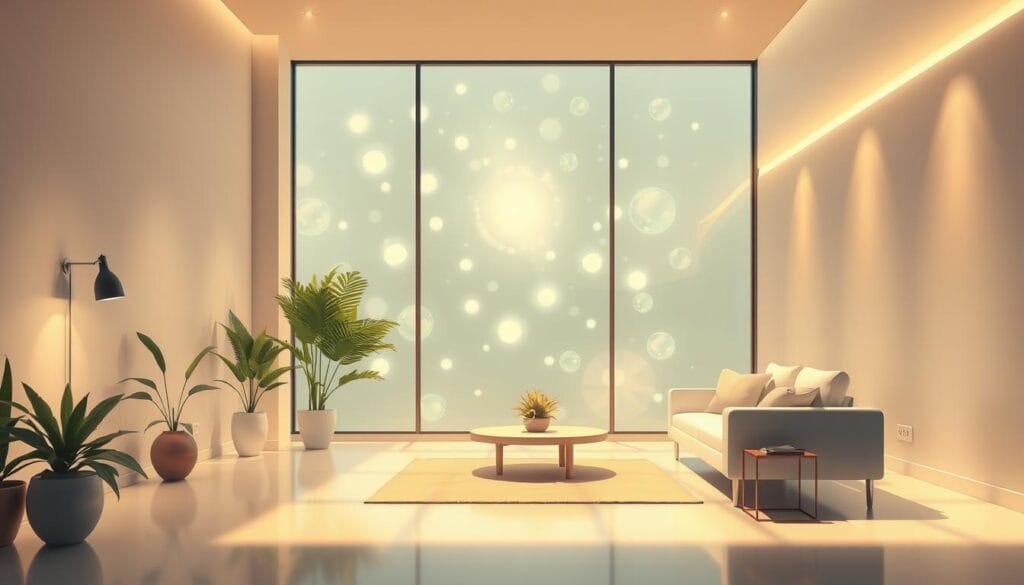
Melanopsin: The Light-Sensitive Protein
Within ipRGCs, a light-sensitive protein called melanopsin is crucial for our emotional light response. This protein is most sensitive to blue light, peaking at 479 nm in humans. This is why blue light has a significant effect on our alertness and mood.
Non-Visual Responses to Light
ipRGCs mediate various non-visual responses to light, including:
- Circadian rhythm regulation
- Pupillary light reflex
- Mood regulation
Understanding these mechanisms is vital for effective lighting design for well-being. By considering how different light types affect our ipRGCs, we can create environments that positively impact our emotional state and health.
The Circadian Rhythm-Mood Connection
Our body’s internal clock, known as the circadian rhythm, is vital for regulating our emotions and well-being. It’s deeply influenced by ambient lighting and emotions, creating a fascinating interplay. This interplay between our environment and mood is complex.
The suprachiasmatic nucleus (SCN), located in the brain, acts as our body’s master timekeeper. It receives direct input from our eyes, processing information about brightness levels and feelings. This connection allows our body to synchronise with the natural light-dark cycle of our surroundings.
Light exposure significantly impacts our circadian rhythms, indirectly affecting our physiology and behaviour. For instance, exposure to bright light in the morning can help regulate our sleep-wake cycle. This leads to improved mood and alertness throughout the day.
“Light is the most potent stimulus for aligning circadian rhythms, which in turn influences our emotional state and overall health.” – Bernadette Pangilinan, Lumenloop
Disruptions in our circadian rhythms are strongly linked to mood disorders. Irregular exposure to light or misaligned sleep patterns can lead to emotional instability. This can even contribute to conditions like seasonal affective disorder (SAD).
| Light Exposure | Circadian Effect | Mood Impact |
|---|---|---|
| Bright morning light | Advances sleep-wake cycle | Improved alertness and mood |
| Dim evening light | Promotes melatonin production | Relaxation and better sleep quality |
| Irregular light exposure | Disrupts circadian rhythm | Mood instability and irritability |
Understanding the connection between ambient lighting and emotions allows us to harness light’s power. By aligning our light exposure with our natural circadian rhythms, we can optimise our emotional state. This improves our mood and cognitive performance throughout the day.
How Lighting Affects Our Emotions: Unveiling the Mechanisms
Lighting is pivotal in shaping our emotional landscape. The interaction between light and our brain’s structures uncovers intriguing insights into mood regulation. We delve into how various lighting aspects influence our feelings and actions.
Direct effects of light on brain structures
Light directly affects brain areas responsible for emotion processing. Exposure to bright light can intensify both positive and negative emotions. This underscores the significance of choosing mood-enhancing lighting in our daily routines.
Light's impact on neurotransmitters and hormones
The type and intensity of light we encounter can significantly alter our body’s chemical balance. Optimal lighting placement can affect neurotransmitter production, such as serotonin. This neurotransmitter is crucial for emotional state regulation.
The role of light intensity and spectral composition
The intensity and colour spectrum of light are crucial in its emotional impact. Blue light, with a wavelength of about 460 nm, has a more alerting effect than green light (550 nm). This disparity is attributed to blue light’s stronger activation of specific eye cells.
| Light Type | Wavelength (nm) | Primary Effect |
|---|---|---|
| Blue Light | 460 | Increased alertness |
| Green Light | 550 | Mild alertness |
| Red Light | 650 | Relaxation |
Grasping these mechanisms empowers us to make informed choices about our lighting environments. By considering factors like intensity, colour, and timing, we can craft spaces that enhance our emotional well-being and cognitive performance all day long.
The Power of Blue Light: Friend or Foe?
Blue light is pivotal in boosting mood and emotions through lighting. It energises us and sharpens focus during daylight. We feel more alert and productive under its influence, whether from the sun or artificial sources.
However, blue light’s impact is not entirely positive. Its effects are more pronounced at night, potentially disrupting sleep due to the disruption of melatonin production. This is especially true for those using electronic devices before bedtime. The blue light from these devices can hinder melatonin production, our sleep hormone. However, it is important to note that some have suggested that it is the stimuli on the screens that impacts our sleep, and not the blue light itself, but there is no conculsive study to prove it.
Blue light at night can be as disruptive as caffeine, keeping us wired when we should be winding down.
The influence of blue light on our emotions and body is profound. Prolonged exposure at night can cause:
- Impaired judgement
- Increased stress levels
- Elevated blood pressure
- Mood swings
To maximise blue light’s benefits while mitigating its drawbacks, we must be cautious about our exposure. Here’s a comparison of blue light effects at different times of day:
| Time of Day | Blue Light Effects | Recommended Action |
|---|---|---|
| Morning | Boosts alertness, improves mood | Seek exposure to natural light |
| Afternoon | Maintains energy levels, enhances productivity | Use blue-enriched artificial light if needed |
| Evening | Can disrupt sleep patterns if overexposed | Reduce screen time, use warm lighting |
By managing our blue light exposure, we can leverage its benefits for mood and emotional enhancement. This approach helps us avoid its negative impacts on our well-being.
Natural Light vs. Artificial Light: Emotional Implications
The impact of light on our emotions is significant, affecting our mood and overall well-being. We will delve into the benefits of natural light, the drawbacks of excessive artificial lighting, and finding a balance for emotional health.
Benefits of Natural Light Exposure
Natural light exposure is vital for emotional balance. Research indicates that office workers with sunlight access exercise more and sleep better. It also helps reduce depression symptoms, especially in those with vitamin D deficiencies. This highlights the role of natural light in fostering a happier environment.
Potential Drawbacks of Excessive Artificial Lighting
Artificial lighting is essential but can be harmful if used too much. Prolonged evening artificial light exposure can upset our circadian rhythm, causing sleep problems. This can lead to mood disorders, showing the importance of thoughtful lighting choices.
Balancing Natural and Artificial Light
Finding a balance between natural and artificial light is crucial for well-being. Here are some tips:
- Maximise natural light during the day
- Use warm, dim lighting in the evening
- Consider light therapy for mood disorders in darker months
- Implement smart lighting systems for automated adjustments
Understanding the emotional effects of different light sources helps us create supportive environments. Light therapy for mood disorders is becoming a recognised treatment, showing the strong connection between lighting and emotional state.
| Light Type | Emotional Benefits | Potential Drawbacks |
|---|---|---|
| Natural Light | Improved mood, better sleep quality | Limited availability in certain seasons |
| Artificial Light | Controlled environment, extended productivity | Potential circadian rhythm disruption |
| Light Therapy | Alleviates symptoms of mood disorders | Requires consistent use for effectiveness |
Light Therapy: How to Defeat SAD & Mood Disorders
Light therapy has emerged as a promising treatment for seasonal affective disorder (SAD) and wider mood disorders, shedding new light on how lighting affects our emotions. This innovative approach involves regular exposure to lamps that mimic natural outdoor light. It offers a beacon of hope for those struggling with emotional well-being.
Research has shown that light therapy can be particularly effective when combined with traditional treatments. A groundbreaking 2015 study revealed that pairing light therapy with antidepressants yielded significantly better results in treating depression compared to antidepressants alone. This finding underscores the profound impact of lighting on emotional response and opens up new avenues for managing depressive symptoms.
While light therapy is not a standalone cure, it has proven to be a valuable tool in the arsenal against mood disorders. By harnessing the power of light, we can potentially alleviate symptoms and improve overall emotional well-being. The therapy works by influencing our circadian rhythms and boosting the production of mood-regulating neurotransmitters. This demonstrates the intricate relationship between lighting and our emotional state.
“Light therapy has given me a new lease on life. It’s amazing how something as simple as controlled light exposure can have such a profound impact on one’s mood and overall sense of well-being.”
As we continue to explore the connection between lighting and emotional response, light therapy stands out as a promising non-invasive treatment option. Its potential to complement existing therapies and provide relief for those suffering from mood disorders highlights the importance of understanding how lighting affects our emotions in both clinical and everyday settings.
Designing Emotionally Intelligent Lighting Solutions
Lighting design for well-being has become a key element in modern architecture and interior design. We now grasp that illumination’s effect on mood extends beyond just seeing. Emotionally intelligent lighting solutions delve into the complex bond between light and human psychology.
These cutting-edge designs focus on light intensity, colour temperature, and timing to foster environments that nurture emotional well-being. By mimicking natural light, these systems help regulate our circadian rhythms and enhance our mood.
Adaptive lighting systems are increasingly popular in both homes and offices. These smart solutions adjust according to the time of day and personal preferences, ensuring the best lighting conditions all day long.
| Lighting Feature | Emotional Impact | Application |
|---|---|---|
| Warm, dim light | Relaxation, calmness | Evening spaces, bedrooms |
| Cool, bright light | Alertness, focus | Office spaces, study areas |
| Dynamic lighting | Improved mood, energy | Living rooms, communal areas |
By integrating these emotionally intelligent lighting solutions, we can craft spaces that are not just aesthetically pleasing but also emotionally enriching. This promotes overall well-being and emotional equilibrium.
The Impact of Lighting on Productivity and Creativity
Lighting is key in shaping our work environments and our performance. The right lighting can greatly enhance productivity and creativity. We’ll delve into how different lighting conditions influence our cognitive abilities and emotional responses in various settings.
Optimal lighting for different tasks and environments
The ideal lighting changes with the task. For tasks needing focus, bright, cool-toned light keeps us alert. On the other hand, warmer, softer lighting boosts creativity by creating a calm atmosphere. Our emotional response to lighting greatly affects our ability to focus and innovate.
| Task | Optimal Lighting | Emotional Effect |
|---|---|---|
| Detailed work | Bright, cool-toned | Increased focus, reduced fatigue |
| Creative brainstorming | Warm, dim | Relaxation, enhanced imagination |
| Collaborative meetings | Balanced, natural light | Improved mood, better communication |
How light influences cognitive performance
Light directly impacts our brain’s functioning. Exposure to bright light during the day boosts alertness and cognitive performance. It suppresses melatonin production, keeping us awake and focused. Proper illumination enhances our mood and mental acuity, linking ambient lighting and emotions closely.
Creating mood-enhancing workspaces with smart lighting
Smart lighting systems are a game-changer in workspace design. They mimic natural light patterns, adjusting colour temperature and intensity throughout the day. This dynamic lighting maintains our circadian rhythms and optimises our emotional response to lighting. By blending task-specific and ambient lighting, we create environments that enhance productivity and wellbeing.
Light and Social Interactions: Setting the Mood
Lighting is crucial in shaping our social experiences. The stark contrast between a well-lit office and a dimly lit pub is striking. These differences in brightness levels can profoundly affect our social interactions.
In restaurants, softer lighting creates a more relaxed atmosphere. This change in ambiance can influence our eating habits, encouraging us to eat more mindfully. Mood-enhancing lighting in dining spaces might also sway our food choices.
Lighting doesn’t just influence our interactions; it can also alter our taste perception. Different lighting conditions can significantly change how we experience flavours, especially in drinks like wine. A warm, soft glow can enhance the richness of red wine, while cooler, brighter light can highlight the crispness of white wine.
“The right lighting can transform a space from ordinary to extraordinary, setting the perfect mood for meaningful connections.”
When planning social gatherings, consider the interplay between brightness and mood. Enhancing emotions with lighting can align with your desired atmosphere. Soft, warm lights can create intimacy and relaxation, while brighter, cooler lights can energise a party atmosphere. All of this ultimately leads to improving mood with lighting if the proper steps are taken.
Understanding light’s impact on social experiences opens up new possibilities for creating memorable moments. By carefully selecting lighting, we can craft settings that enhance our social interactions, making them more engaging and enjoyable.
Future Directions in Lighting Research and Technology
The future of lighting is brimming with promise, with groundbreaking advancements on the horizon. We’re witnessing a move towards more tailored and adaptive lighting solutions. These are designed to meet individual needs and preferences.
Personalised Lighting Solutions
Lighting’s role in enhancing mood is evolving rapidly. Future systems might adjust automatically to our natural rhythms. This could significantly boost our mood and well-being throughout the day. When selecting luminaires for your home, there are many mood-enhancing lighting choices to conisder, such as colour temperature, dimming protocols and direct/indirect applications.
Integration with Environmental Factors
Lighting is now part of a broader ecosystem, integrating with elements like temperature and air quality. This holistic approach aims to create spaces that are not just well-lit. They are also comfortable and supportive of our overall health.
Advancements in Human-Centric Design
Human-centric lighting design is a term thrown around a lot these days but essentially it just means lighting for a happier space. These systems aim to optimise light for both visual and non-visual effects. This could potentially revolutionise our living and working spaces.
| Lighting Aspect | Current Approach | Future Direction |
|---|---|---|
| Mood Enhancement | Static lighting settings | Dynamic, personalised lighting |
| Environmental Integration | Separate systems | Fully integrated smart environments |
| Design Focus | Primarily visual effects | Balanced visual and non-visual effects |
As research continues, we can look forward to even more innovative ways to improve mood with lighting. The future of lighting promises to not just enhance our spaces. It will also significantly improve our lives.
Conclusion
The connection between lighting and emotions is vast and significant. Our studies in light psychology reveal that light impacts us from the smallest eye cells to our mental health. This understanding offers new avenues for enhancing our emotional states through lighting.
Light influences our body clock, mood, and social interactions. Both natural and artificial light are essential in our daily routines. By applying this knowledge, we can design lighting that supports our emotional health all day long.
The future of lighting design is promising. We’re heading towards customised lighting that meets our personal needs. This field of light psychology aims to enhance our mental health and quality of life. As we delve deeper into how light affects our emotions, we’re creating a brighter, more emotionally balanced future.
FAQ
What are intrinsically photosensitive retinal ganglion cells (ipRGCs), and how do they influence our emotions?
ipRGCs are a unique type of retinal cell that responds directly to light. They are key in non-visual light responses, such as managing our circadian rhythms and mood. These cells contain melanopsin, a photopigment most sensitive to blue light. This allows light to directly affect our emotional state by sending signals to mood-regulating brain regions.
How does light influence our circadian rhythms, and why is this important for our emotional well-being?
Our circadian rhythms, which control our sleep-wake cycles and other physiological processes, are regulated by the suprachiasmatic nucleus (SCN) in the brain. Light, especially blue wavelengths, can shift these rhythms. Disruptions in these rhythms are linked to mood disorders, highlighting the importance of light in emotional balance.
What are the direct effects of light on brain structures involved in emotion regulation?
Light impacts brain areas like the amygdala and hippocampus, crucial for emotion control. Bright light can intensify both positive and negative emotions. Blue light during the day boosts alertness and cognitive performance.
Is blue light always beneficial for our emotional well-being?
Blue light has both positive and negative effects on emotions. It increases energy and cognitive function during the day. However, blue light from screens before bed can suppress melatonin, disrupting sleep and causing emotional and physical issues.
How does natural light exposure benefit our emotional state compared to artificial lighting?
Natural light exposure is linked to better mood, sleep, and overall well-being. Studies show office workers with natural light access exercise more and sleep better. Sunlight may also help alleviate depression symptoms. Yet, artificial lighting is necessary in many settings and should be balanced with natural light.
What is light therapy, and how can it be used to treat mood disorders?
Light therapy involves using lamps that mimic natural outdoor light. It shows promise in treating depression, especially when combined with other treatments like antidepressants. While not a cure alone, it can be a valuable tool in managing depressive symptoms.
How can lighting solutions be designed to support emotional well-being?
Emotionally intelligent lighting considers light intensity, spectral composition, and timing. It aims to create environments that enhance emotional well-being. This includes adaptive systems that adjust based on time and individual preferences, as well as task-specific lighting for optimal performance.
How does lighting affect productivity and creativity in work environments?
Bright light enhances cognitive performance and alertness. Dimmer lighting can boost creativity in certain situations. Smart lighting systems that adjust throughout the day can support work environments by maintaining circadian rhythms and cognitive function.
How does lighting influence social interactions and mood setting?
Lighting significantly impacts social interactions and mood. Dimmer, softer lighting in restaurants can lead to slower eating and healthier choices. It can also affect taste perception, especially in beverages like wine.
What are some future directions in lighting research and technology?
Future lighting research and technology aim for personalized, adaptive solutions that align with individual circadian rhythms and preferences. Integration with factors like temperature and air quality is also emerging. Advancements in human-centric lighting design focus on optimizing light for both visual and non-visual effects, potentially revolutionizing our lighting needs.
